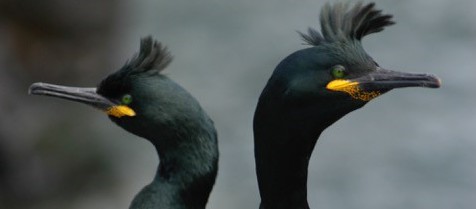NEWS STORY: Bird tracking aids seabird research
Bird tracking technology reveals future climate may affect seabird feeding behaviour
A two year study of shags on the Isle of May National Nature Reserve in Scotland reveals that when winds are strong, female birds take much longer to find food compared with males.

Reporting in the Journal of Animal Ecology scientists from the University of Edinburgh and the Centre for Ecology and Hydrology (CEH) describe how they used loggers designed by British Antarctic Survey (BAS) to track the feeding trips of 75 of one of the UK’s most common seabirds. The team found that females, being smaller and lighter than the males, have to work harder to dive through turbulent water to catch fish. If future climate predictions, which forecast stronger winds, are correct then researchers suggest that this could affect the number of breeding birds.
Richard Phillips, a senior bird ecologist at BAS, says:
“We fitted tiny loggers to 88 birds and were able to recover data from 75 of them. Each logger captured information about the timings of landings and take-offs in saltwater, and from this we can calculate foraging time. There was a marked difference between males and females in their response to poor weather conditions was. It is likely that in a future climate change scenario where there is an increase in storms that the ability of each sex to cope in these conditions will be different.”
Scientists say their findings may apply to other species where there are differences between the sexes in foraging capabilities.
Dr. Sue Lewis, of the University of Edinburgh’s School of Biological Sciences, led the research: “In our study, females had to work harder than males to find food, and difficult conditions exacerbated this difference. Forecasted increases in wind speeds could have a greater impact on females, with potential knock-on effects on the well-beings of populations.”The research, carried out as part of a long term CEH study on the island started in the 1970s, was funded by the Natural Environment Research Council (NERC).